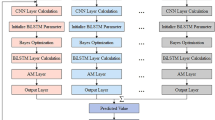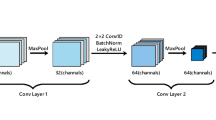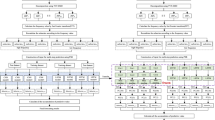Abstract
The non-linearity and non-stationarity of runoff series pose significant challenges to runoff forecasting, and conventional single forecasting models struggle to accurately capture the internal dynamics of the series. To address this issue, we propose a runoff prediction model named AFDM-MTCN, which combines the adaptive Fourier decomposition method (AFDM) and multiscale temporal convolutional network (MTCN). AFDM-MTCN consists of two stages: adaptive decomposition and multi-scale feature extraction. In the adaptive decomposition stage, the improved Fourier decomposition method (IFDM) is optimized using the Sparrow Search Algorithm to enhance its ability to extract temporal patterns. In the multi-scale feature extraction stage, improvements are made to the temporal convolutional network (TCN) through the use of multi-scale convolution kernels, skip connections, and depth-wise separable convolution, to capture information from multiple angles, enhance information propagation, and reduce training parameters. The model was applied to two hydrological stations in the Weihe River Basin and compared with state-of-the-art methods to assess its accuracy and feasibility. The results demonstrate that AFDM-MTCN exhibits satisfactory performance in runoff prediction. Furthermore, compared to other decomposition techniques, AFDM demonstrates stronger capability in extracting patterns from non-stationary runoff data.













Similar content being viewed by others
Availability of data and materials
The data comes from the Yellow River Water Conservancy Commission of the Ministry of Water Resources of China, which can be found at http://61.163.88.227:8006/hwsq.aspx.
References
Adnan RM, Mostafa RR, Kisi O et al (2021) Improving streamflow prediction using a new hybrid elm model combined with hybrid particle swarm optimization and grey wolf optimization. Knowledge-Based Systems 230:107379. https://doi.org/10.1016/j.knosys.2021.107379
Bai S, Kolter JZ, Koltun V (2018) An empirical evaluation of generic convolutional and recurrent networks for sequence modeling. arXiv preprint arXiv:1803.01271
Chen Y, Wang J (2020) Ecological security early-warning in central yunnan province, china, based on the gray model. Ecological Indicators 111:106000. https://doi.org/10.1016/j.ecolind.2019.106000
Clarke RT (2007) Hydrological prediction in a non-stationary world. Hydrology and Earth System Sciences 11(1):408–414. https://doi.org/10.5194/hess-11-408-2007
Fang S, Xu L, Pei H et al (2013) An integrated approach to snowmelt flood forecasting in water resource management. IEEE transactions on industrial informatics 10(1):548–558
Gao S, Huang Y, Zhang S et al (2020) Short-term runoff prediction with gru and lstm networks without requiring time step optimization during sample generation. Journal of Hydrology 589:125188. https://doi.org/10.1016/j.jhydrol.2020.125188
Gu R, Chen J, Hong R et al (2020) Incipient fault diagnosis of rolling bearings based on adaptive variational mode decomposition and teager energy operator. Measurement 149:106941. https://doi.org/10.1016/j.measurement.2019.106941
He D, Liu C, Jin Z et al (2022) Fault diagnosis of flywheel bearing based on parameter optimization variational mode decomposition energy entropy and deep learning. Energy 239:122108. https://doi.org/10.1016/j.energy.2021.122108
He K, Zhang X, Ren S, et al (2016) Identity mappings in deep residual networks. In: Computer Vision–ECCV 2016: 14th European Conference, Amsterdam, The Netherlands, October 11–14, 2016, Proceedings, Part IV 14, Springer, pp 630–645, https://doi.org/10.1007/978-3-319-46493-0_38
Katipoğlu OM, Sarıgöl M (2023) Coupling machine learning with signal process techniques and particle swarm optimization for forecasting flood routing calculations in the eastern black sea basin, türkiye. Environmental Science and Pollution Research pp 1–18
Kim T, Yang T, Gao S et al (2021) Can artificial intelligence and data-driven machine learning models match or even replace process-driven hydrologic models for streamflow simulation?: A case study of four watersheds with different hydro-climatic regions across the conus. Journal of Hydrology 598:126423. https://doi.org/10.1016/j.jhydrol.2021.126423
Li Y, Chang J, Wang Y et al (2016) Spatiotemporal impacts of climate, land cover change and direct human activities on runoff variations in the wei river basin, china. Water 8(6):220. https://doi.org/10.3390/w8060220
Mirjalili S, Lewis A (2016) The whale optimization algorithm. Advances in engineering software 95:51–67. https://doi.org/10.1016/j.advengsoft.2016.01.008
Mirjalili S, Mirjalili SM, Lewis A (2014) Grey wolf optimizer. Advances in engineering software 69:46–61. https://doi.org/10.1016/j.advengsoft.2013.12.007
Samantaray S, Das SS, Sahoo A et al (2022) Monthly runoff prediction at baitarani river basin by support vector machine based on salp swarm algorithm. Ain Shams Engineering Journal 13(5):101732. https://doi.org/10.1016/j.asej.2022.101732
Singh P, Joshi SD, Patney RK et al (2017) The fourier decomposition method for nonlinear and non-stationary time series analysis. Proceedings of the Royal Society A: Mathematical, Physical and Engineering Sciences 473(2199):20160871. https://doi.org/10.1098/rspa.2016.0871
Valipour M (2015) Long-term runoff study using sarima and arima models in the united states. Meteorological Applications 22(3):592–598
Wang J, Shi P, Jiang P et al (2017) Application of bp neural network algorithm in traditional hydrological model for flood forecasting. Water 9(1):48. https://doi.org/10.3390/w9010048
Wc Wang, Kw Chau, Qiu L et al (2015) Improving forecasting accuracy of medium and long-term runoff using artificial neural network based on eemd decomposition. Environmental research 139:46–54
Wang X, Zhang S, Qiao H et al (2022) Mid-long term forecasting of reservoir inflow using the coupling of time-varying filter-based empirical mode decomposition and gated recurrent unit. Environmental Science and Pollution Research 29(58):87200–87217
Wanliang W, Mingzhi H, Rengong Z et al (2022) Monthly runoff prediction model of lushui river basin based on improved tcn and lstm. Computer Integrated Manufacturing System 28(11):3558
Xie T, Zhang G, Hou J et al (2019) Hybrid forecasting model for non-stationary daily runoff series: a case study in the han river basin, china. Journal of Hydrology 577:123915. https://doi.org/10.1016/j.jhydrol.2019.123915
Xue J, Shen B (2020) A novel swarm intelligence optimization approach: sparrow search algorithm. Systems science & control engineering 8(1):22–34
Yu X, Zhang X, Qin H (2018) A data-driven model based on fourier transform and support vector regression for monthly reservoir inflow forecasting. Journal of Hydro-environment Research 18:12–24
Yuan X, Chen C, Lei X et al (2018) Monthly runoff forecasting based on lstm-alo model. Stochastic environmental research and risk assessment 32:2199–2212
Zhang J, Chen X, Khan A et al (2021) Daily runoff forecasting by deep recursive neural network. Journal of Hydrology 596:126067
Zhang X, Zhao D, Duan B et al (2022) A novel groundwater burial depth prediction model-based on the combined vmd-wsd-elman model. Environmental Science and Pollution Research 29(50):76310–76320
Zhang Y, Chiew FH, Li M et al (2018) Predicting runoff signatures using regression and hydrological modeling approaches. Water Resources Research 54(10):7859–7878
Zhou J, Peng T, Zhang C et al (2018) Data pre-analysis and ensemble of various artificial neural networks for monthly streamflow forecasting. Water 10(5):628. https://doi.org/10.3390/w10050628
Funding
This work is partially supported by National Natural Science Foundation of China under Grant (No. 61873240), the Key Research and Development Program of Zhejiang Province (No. 2023C01168, 2023C03189) and Research incubation Foundation of Hangzhou City University (No. J202316).
Author information
Authors and Affiliations
Contributions
Lijin Yu: investigation, modeling, calculation, writing—original draft. Zheng Wang: conceptualization, methodology. Rui Dai: writing—review and editing. Wanliang Wang: data curation, investigation, supervision. All authors have read and approved the fnal manuscript.
Corresponding author
Ethics declarations
Ethical approval
Not applicable.
Consent to participate
Not applicable.
Consent for publication
Not applicable.
Competing interests
The authors declare no competing interests.
Additional information
Responsible editor: Marcus Schulz.
Publisher's Note
Springer Nature remains neutral with regard to jurisdictional claims in published maps and institutional affiliations.
Rights and permissions
Springer Nature or its licensor (e.g. a society or other partner) holds exclusive rights to this article under a publishing agreement with the author(s) or other rightsholder(s); author self-archiving of the accepted manuscript version of this article is solely governed by the terms of such publishing agreement and applicable law.
About this article
Cite this article
Yu, L., Wang, Z., Dai, R. et al. Daily runoff prediction based on the adaptive fourier decomposition method and multiscale temporal convolutional network. Environ Sci Pollut Res 30, 95449–95463 (2023). https://doi.org/10.1007/s11356-023-28936-5
Received:
Accepted:
Published:
Issue Date:
DOI: https://doi.org/10.1007/s11356-023-28936-5




